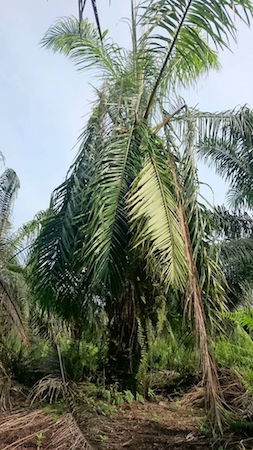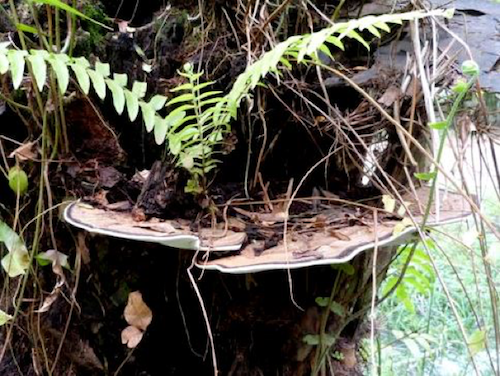Budidaya Kelapa Sawit Berkelanjutan / Ganoderma
< Budidaya Kelapa Sawit BerkelanjutanLatar belakang
Ganoderma, juga dikenal sebagai basal stem rot atau busuk pangkal batang, merupakan infeksi jamur pada kelapa sawit. Pada kasus infeksi Ganoderma yang serius, bisa menyebabkan kematian pada pohon sawit. Perkebunan yang lebih tua memiliki lebih dari 50 persen tingkat kematian dalam kendala munculnya Ganoderma ini. Karena belum adanya metode penyembuhan untuk infeksi Ganoderma ini, penyebarannya bisa ditekan melalui manajemen yang baik.
Ganoderma tersebar melalui 2 cara:
- Melalui tanah dari adanya rangkaian jamur;
- Melalui udara dengan penyebaran spora yang berasal dari jamur (bracket) yang tumbuh pada batang sawit yang terinfeksi 1.
Tidak semua sawit yang terinfeksi memiliki bracket pada batangnya. Jika satu pohon sawit terinfeksi oleh Ganoderma, gejala yang berbeda dapat dilihat, seperti menguningnya daun muda, akumulasi beberapa daun muda yang tumbuhnya tidak terbuka (daun tombak) di tengah-tengah kanopi, atau selingkar pelepah sengkleh yang tergantung memutar pada batang (lihat: Gambar 11). Biasanya, sawit masih akan tetap produktif meskipun memperlihatkan gejala infeksi Ganoderma, namun akan mati dalam kurun waktu setahun.
Tujuan
Untuk meminimalisir penyebaran Ganoderma di areal perkebunan
Standarisasi
- Bracket (lihat: Gambar 12) disingkirkan dari sawit yang terinfeksi dan dihancurkan;
- Tanah di dasar pohon sawit yang terinfeksi diuruk melingkar mengitari pohon;
- Pohon sawit yang mati disingkirkan dari dari areal perkebunan kemudian dibakar;
- Remediasi: Lahan perkebunan didiamkan tanpa penanaman sawit setidaknya selama 12 bulan setelah pemotongan pohon sawit lama.
Peralatan dan perlengkapan
- Parang (untuk memotong bracket dari pohon)
- Gergaji mesin
- Sekop atau mesin penggali tanah
Waktu pelaksanaan
- Menyingkirkan bracket: sesegera mungkin setelah ditemukan;
- Pengurukan tanah: sesegera mungkin setelah ditemukan gejala infeksi Ganoderma;
- Remediasi: setelah penebangan, sebelum penanaman kembali.
Frekuensi
Tergantung pada tingkat munculnya dan kecepatan infeksi baru yang muncul.
Kebutuhan waktu tenaga kerja
- Menyingkirkan bracket: beberapa menit per sawit;
- Pengurukan tanah: 30 menit per sawit;
- Penebangan dan pembuangan pohon sawit: beberapa jam per sawit, tergantung dari peralatan yang tersedia.
Tenaga kerja
Para petani beserta keluarganya atau karyawan harian lepas.
Cara pelaksanaan
Untuk mengendalikan Ganoderma, ikuti langkah-langkah berikut:
| Step 1. | During harvesting or other field activities look at the palms carefully and note any yellowing or dying of leaves, or the appearance of brackets on the trunks. In particular, look for the following: |
| Step 2. | If there are signs which might indicate Ganoderma, then check the trunk carefully at every harvesting round for signs of brackets. If brackets do not appear within a few weeks, then it is likely that they will not appear later on. If the palm has brackets, then these should be cut off, taken out of the plantation, and destroyed (burned). |
| Step 3. | To slow the progress of the disease in the palm, it can help to mount soil around the base of palms which show early signs of infection. To do this make a heap of soil up to 75 cm high and 50 cm wide around the trunk. The disease progress should slow down.
Note: this option is labour-intensive and will probably not stop the disease in the end. |
| Step 4. | To prevent spreading of the disease from root to root, plantations often remove sick palms entirely. For smallholders without chain saws or heavy machines, removing the palms can be very labour-intensive, so it is up to each farmer to decide if he wants to do this or not.
If the decision has been made to remove infected palms then follow these steps:
|
Note: When Ganoderma symptoms are observed, the palm has already been infected for quite some time. Therefore, even when taking the measures described above, the disease can still spread. There is still much that is unclear about the best way to deal with Ganoderma, even though it is a very common and destructive disease. The best time to prevent Ganoderma is at the replanting stage. Currently, it is recommended to remove all diseased palms and also the roots and the soil from a 2x2-meter hole of 1-meter deep, and to wait at least one year before planting any new oil palms. The new palms should be planted where previously the frond piles and harvesting paths were located, as far from the previous planting holes as possible.
Data recording
Every disease control activity should be recorded in a logbook as shown in the example below.
| Date | Time | Location | Activity | Input type | Input amount | Input costs | Labour input | Labour costs | |
| People | Hours | ||||||||
| 16/01/13 | Field 3 | Removing Ganoderma brackets | 1 | 4 | 40000 | ||||
References
- ↑ R.H.V. Corley, P.B. Tinker, The Oil Palm, fourth ed., Blackwell Science, Oxford, UK, 2003.
- ↑ I.R. Rankine, T.H. Fairhurst, Field Handbook: Oil Palm Series, Volume 3 – Mature, second ed., Potash & Phosphate Institute (PPI), Singapore, 1999.
- ↑ G.F. Chung, Management of Ganoderma diseases in oil palm plantations, The Planter, 87 (2011) 325—339.
Acknowledgements
The material from Ganoderma is sourced from Smallholder Oil Palm Handbook and put together by Lotte Suzanne Woittiez (Wageningen Universit) and Haryono Sadikin, Sri Turhina, Hidayat Dani, Tri Purba Dukan, and Hans Smit (SNV) in August 2016. See Module 5: Pests and Diseases for more information.




